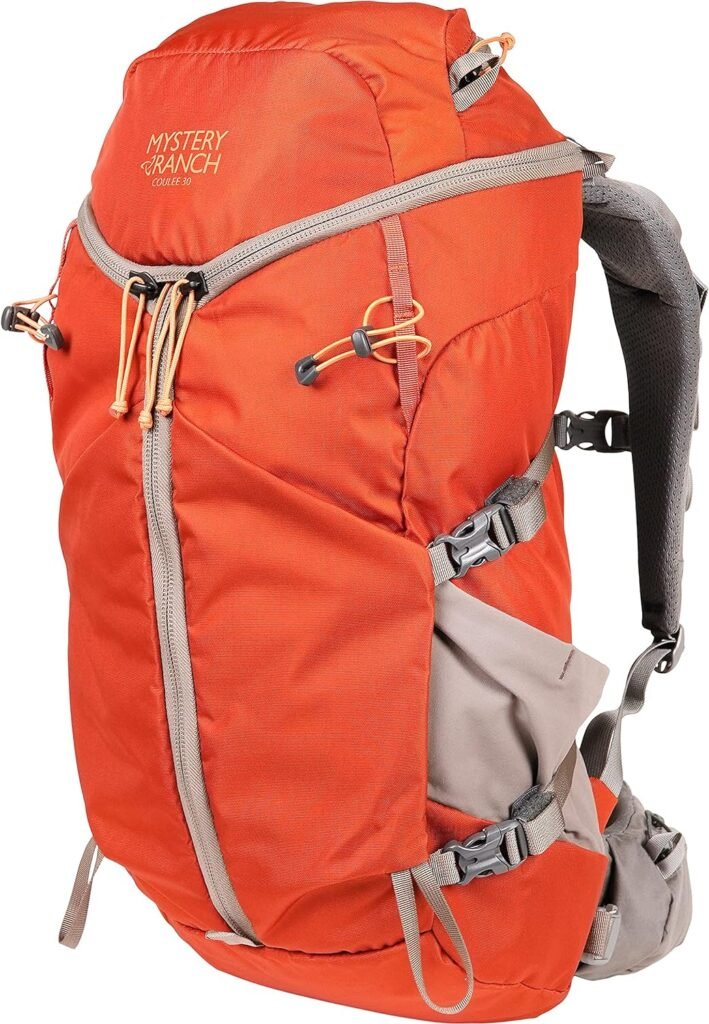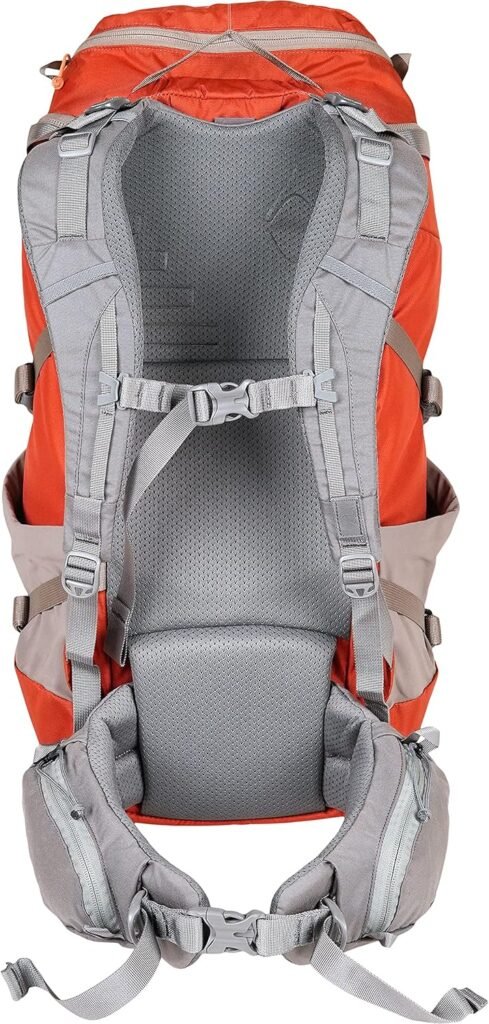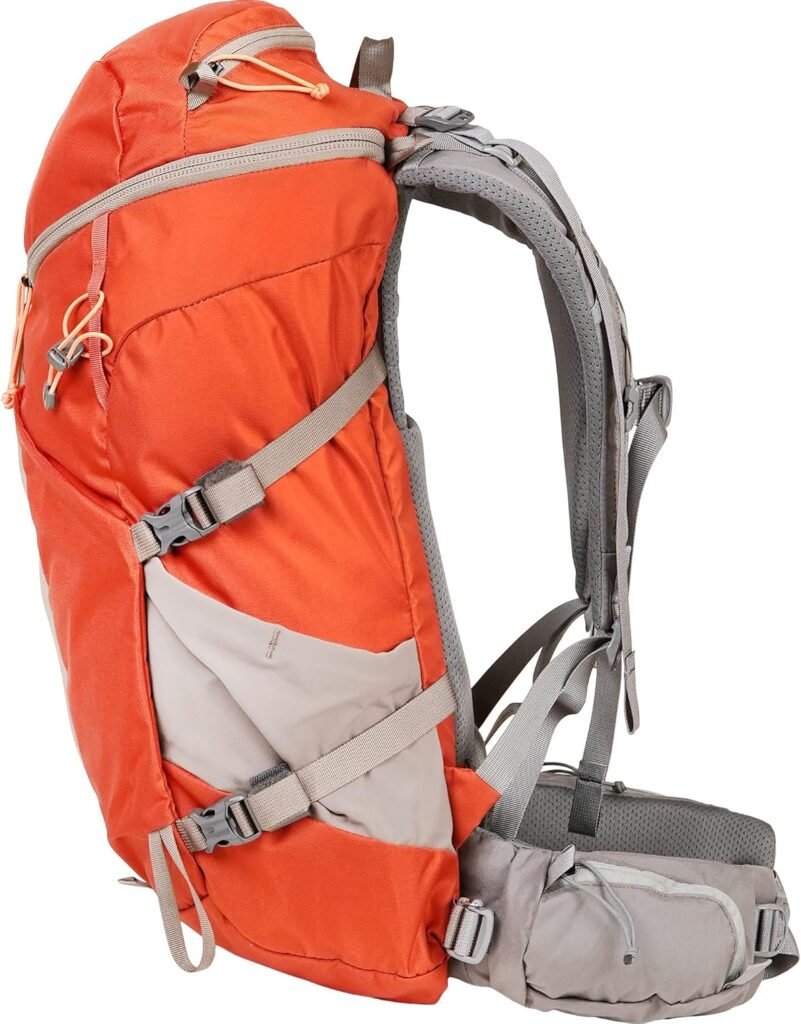Brief Overview
The Mystery Ranch Coulee 30 is a versatile and well-designed backpack that caters to the needs of outdoor enthusiasts, day hikers, and those seeking a reliable companion for their urban adventures. As part of the brand’s renowned Coulee series, this 30-liter pack offers a compelling blend of functionality, comfort, and thoughtful features that set it apart in the competitive daypack market.
Crafted with the renowned attention to detail and quality that has made Mystery Ranch a trusted name in the industry, the Coulee 30 is a backpack that can seamlessly transition between the trail and the city, providing users with a durable and adaptable carrying solution for a wide range of activities and environments.
Mystery Ranch Coulee 30

Specifications
- Capacity: 30 liters
- Weight: 3.1 lbs (1.4 kg)
- Dimensions: 25 x 12 x 12 inches (63.5 x 30.5 x 30.5 cm)
- Material:
- Body: 330D Robic nylon fabric
- Reinforcement: 420D Robic nylon fabric
- Frame System: Internal HDPE frame sheet with dual composite stays
- Access: 3-ZIP design for quick and easy access to the main compartment
- Hydration: Compatible with hydration reservoirs (sold separately)
First Impressions
Upon first glance, the Mystery Ranch Coulee 30 conveys a sense of rugged sophistication. The backpack’s clean, minimalist aesthetic, combined with its robust construction, immediately signals that this is a product built to withstand the rigors of an active lifestyle. The muted color schemes and subtle branding contribute to an overall appearance that is both understated and premium, hinting at the level of care and attention that has been poured into its design.
Unzipping the main compartment reveals a generously sized interior, with ample space for day-to-day essentials, outdoor gear, or a combination of both. The thoughtful organization of the pack’s various pockets and compartments suggests a well-considered approach to maximizing the available storage capacity, ensuring that users can easily access and manage their belongings while on the move.
What We Like
One of the standout features of the Mystery Ranch Coulee 30 is its exceptional comfort and load-carrying capabilities. The backpack’s contoured shoulder straps, padded back panel, and adjustable waist belt work in tandem to provide a secure and supportive fit, distributing the weight of the load evenly and mitigating the strain on the user’s body, even during extended periods of wear.

The Coulee 30’s versatility is another key strength, as it seamlessly transitions between the demands of the trail and the urban environment. The pack’s sleek, low-profile design allows it to blend in effortlessly in a variety of settings, while its comprehensive feature set ensures that it remains a capable and practical companion for a wide range of activities, from day hikes and commuting to travel and everyday use.
Another aspect that impresses is the Coulee 30’s exceptional build quality and attention to detail. The use of durable, high-quality materials, such as the reinforced nylon fabric and YKK zippers, combined with thoughtful construction techniques, suggests a backpack that is built to withstand the rigors of an active lifestyle. This level of craftsmanship and attention to detail instills a sense of confidence in the product’s long-term durability and reliability.
What We Don’t
While the Mystery Ranch Coulee 30 is undoubtedly a premium-quality daypack, its relatively high price point may be a deterrent for some consumers, particularly those on a tighter budget or who are new to the outdoor gear market. The backpack’s robust construction and comprehensive feature set come at a premium, and it may not be the most accessible option for those looking to minimize their initial investment in hiking and outdoor gear.
Additionally, the Coulee 30’s sleek and streamlined design, while contributing to its versatility, may limit the overall volume and organizational capabilities of the pack compared to some of its more purpose-built competitors. While the backpack’s internal layout is thoughtful and efficient, users with a need for extensive storage or specialized compartmentalization may find that the Coulee 30 falls short of their specific requirements.
The Specs
Key Features
- Design: The Mystery Ranch Coulee 30 features a clean, minimalist aesthetic that seamlessly blends form and function. The backpack’s low-profile silhouette and subtle branding contribute to a sophisticated, understated appearance that allows it to transition effortlessly between outdoor and urban settings.
- Fit: The Coulee 30 is designed with a focus on comfort and load-carrying performance, boasting a contoured shoulder strap system and a padded, ventilated back panel. The adjustable waist belt helps to distribute the weight of the pack evenly, providing a secure and supportive fit that minimizes strain on the user’s body, even during extended periods of wear.
- Materials: The Mystery Ranch Coulee 30 is constructed using high-quality, durable materials that prioritize long-term reliability and performance. The main body of the pack is crafted from a reinforced nylon fabric, known for its strength and resistance to abrasion, while the use of YKK zippers ensures smooth, reliable operation over the life of the product.
- Dimensions: The Coulee 30 offers a generous 30-liter capacity, providing ample space for day-to-day essentials, outdoor gear, or a combination of both. The backpack’s dimensions of 20 inches in height, 12 inches in width, and 8 inches in depth strike a balance between storage volume and overall portability, making it a versatile choice for a wide range of activities and environments.
- Weight: At just 2.83 pounds (1.28 kg), the Mystery Ranch Coulee 30 is a relatively lightweight daypack, ensuring that users can comfortably carry their gear without sacrificing the backpack’s overall durability and feature set. This balance between weight savings and robust construction is a hallmark of the brand’s design philosophy.
- Convenient Features: The Coulee 30 is equipped with a variety of thoughtful features that enhance the user experience and provide convenient access to essential items. These include a dedicated laptop sleeve, multiple exterior pockets for organization, and a padded grab handle for easy carrying when not on the user’s back.
Overall Performance
The Mystery Ranch Coulee 30 delivers a well-rounded performance that caters to the needs of a wide range of outdoor enthusiasts and urban dwellers. The backpack’s comfortable fit, versatile design, and durable construction ensure that it can reliably handle the demands of day hikes, commutes, and everyday carry tasks with equal aplomb.

The Coulee 30’s ability to seamlessly transition between different environments and activities is a particular highlight, as it allows users to enjoy the benefits of a high-quality outdoor-focused backpack without sacrificing its suitability for more urban-centric uses. Whether navigating the trails or navigating the city streets, the Coulee 30 remains a capable and trusted companion.
Overall Durability
The Mystery Ranch Coulee 30 is built to withstand the rigors of an active lifestyle, with a focus on long-term reliability and performance. The backpack’s use of reinforced nylon fabrics, rugged hardware, and thoughtful construction techniques ensure that it can reliably handle the wear and tear of regular use, whether it’s enduring the elements on the trail or the daily grind of commuting and everyday carry.
Adjustability
The Coulee 30’s well-designed fit system, featuring adjustable shoulder straps and a contoured, padded waist belt, allows users to fine-tune the backpack’s fit to their individual body shape and preferences. This level of adjustability not only enhances comfort but also ensures a secure and stable carry, even when the pack is fully loaded.

Best Uses
Seasonal Use
The Mystery Ranch Coulee 30 is a versatile daypack that can be enjoyed year-round, making it a suitable companion for a variety of outdoor activities and weather conditions. From spring hikes and summer day trips to autumn commutes and winter urban explorations, the Coulee 30 remains a reliable and capable choice, adapting to the changing needs of the user and the environment.
Environment
The Coulee 30’s combination of durable construction, compact design, and thoughtful features make it an excellent choice for a wide range of environments, both on and off the trail. Whether navigating the backcountry, commuting through the city, or traveling to new destinations, this backpack is well-equipped to handle the demands of an active lifestyle, providing users with a versatile and dependable carrying solution.
Comparison to Other Backpacks on the Market
In the competitive daypack market, the Mystery Ranch Coulee 30 stands out as a premium and highly capable option that offers a compelling blend of features, comfort, and durability. When compared to its contemporaries, the Coulee 30 boasts several key advantages that make it a compelling choice for discerning outdoor enthusiasts and urban adventurers alike.
Comfort and Load-Carrying Performance
One of the Coulee 30‘s primary strengths is its exceptional comfort and load-carrying performance, thanks to its contoured shoulder straps, padded back panel, and adjustable waist belt. This level of support and weight distribution is not always found in more streamlined daypack designs, making the Coulee 30 a standout choice for those who value all-day comfort and the ability to carry heavier loads without fatigue.
Competing Backpacks:
- Osprey Talon 33: Known for its lightweight design and excellent ventilation, but lacks the robust support system of the Coulee 30.
- Deuter Futura 30: Offers great comfort and ventilation but is slightly heavier and less versatile in urban settings.
Versatile Design
The backpack’s versatile design and ability to seamlessly transition between outdoor and urban settings is another key differentiator. While many daypacks may be tailored towards specific use cases, the Coulee 30 manages to strike a balance, offering a sleek, low-profile aesthetic that allows it to blend in effortlessly in a variety of environments, while still maintaining the robust construction and thoughtful features required for outdoor activities.
Competing Backpacks:
- Patagonia Black Hole 32L: Highly durable and water-resistant but lacks the specialized outdoor features of the Coulee 30.
- The North Face Borealis: Excellent for urban use with a stylish design, but not as rugged or feature-rich for outdoor adventures.
Build Quality and Durability
Additionally, the Coulee 30‘s exceptional build quality and attention to detail, as evidenced by its use of durable materials and premium hardware, set it apart from some of its more budget-oriented competitors. This attention to craftsmanship and long-term reliability can be a significant draw for consumers who value the peace of mind that comes with investing in a high-quality product.
Competing Backpacks:
- Gregory Zulu 30: Offers excellent build quality and comfort but is heavier and bulkier than the Coulee 30.
- REI Co-op Trail 25: More affordable with decent build quality, but lacks the premium materials and features of the Coulee 30.
Price Considerations
That said, the Coulee 30‘s relatively high price point may be a deterrent for some consumers, particularly those on a tighter budget or who are new to the world of premium outdoor gear. While the backpack’s features and performance justify the investment for many users, it may not be the most accessible option for those looking to minimize their initial gear expenditure.
Competing Backpacks:
- Kelty Redwing 32: Offers a good balance of features and affordability but doesn’t match the premium feel and durability of the Coulee 30.
- Teton Sports Oasis 1100: Extremely budget-friendly with basic features, but lacks the comfort and durability of the Coulee 30.
Our Final Thoughts
The Mystery Ranch Coulee 30 is a standout daypack that effortlessly blends functionality, comfort, and versatility, making it a compelling choice for a wide range of outdoor enthusiasts and urban adventurers. With its robust construction, thoughtful design features, and exceptional load-carrying performance, the Coulee 30 sets a new standard for what can be expected from a premium-quality backpack.
One of the key strengths of the Coulee 30 is its ability to seamlessly transition between different environments and activities, allowing users to enjoy the benefits of a high-quality outdoor-focused backpack without sacrificing its suitability for more urban-centric use cases. Whether navigating the trails or commuting through the city, the Coulee 30 remains a capable and reliable companion, providing a comfortable and well-organized carrying solution for a wide range of gear and essentials.
While the backpack’s relatively high price point may be a deterrent for some consumers, the Coulee 30’s uncompromising quality, feature set, and overall performance make it a worthwhile investment for those who value durability, comfort, and versatility in their outdoor gear. The backpack’s thoughtful design and attention to detail instill a sense of confidence in the product’s long-term reliability, ensuring that users can confidently embark on their adventures without the worry of premature wear or failure.
Ultimately, the Mystery Ranch Coulee 30 is a testament to the brand’s commitment to delivering exceptional products that cater to the needs of both outdoor enthusiasts and urban dwellers. Its combination of comfort, versatility, and robust construction make it a standout choice in the daypack market, setting a new benchmark for what can be achieved in a premium-quality backpack. For the discerning consumer seeking a reliable, high-performance companion for their active lifestyle, the Coulee 30 delivers on every front, making it a worthy addition to any adventurer’s gear arsenal.
FAQ
Q. What is the capacity of the Mystery Ranch Coulee 30?
The Mystery Ranch Coulee 30 offers a generous 30-liter capacity, providing ample space for day-to-day essentials, outdoor gear, or a combination of both.
Q. Is the Coulee 30 suitable for both outdoor and urban use?
Yes, the Coulee 30’s versatile design allows it to seamlessly transition between outdoor and urban environments, making it a reliable companion for a wide range of activities.
Q. What materials are used in the construction of the Coulee 30?
The Coulee 30 is constructed using high-quality, durable materials, including reinforced nylon fabric and YKK zippers, ensuring long-term reliability and performance.
Q. How much does the Mystery Ranch Coulee 30 weigh?
The Coulee 30 weighs just 2.83 pounds (1.28 kg), making it a relatively lightweight daypack that balances weight savings with robust construction.
Q. What are the key features of the Mystery Ranch Coulee 30?
Key features of the Coulee 30 include a clean, minimalist design, a focus on comfort and load-carrying performance, high-quality materials, a generous 30-liter capacity, and a variety of convenient features such as a dedicated laptop sleeve and multiple exterior pockets for organization.
![]()





























